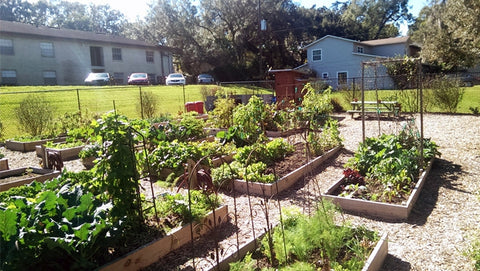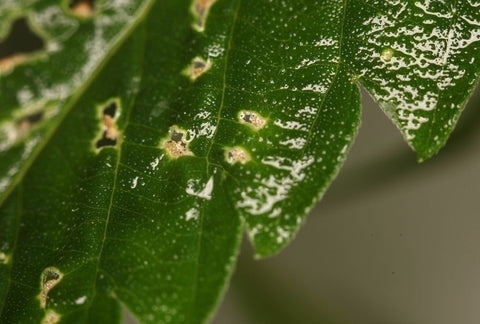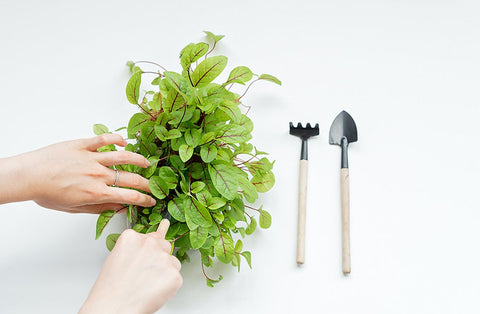An allotment (British term), or in North America, a community garden, is a plot of land made available for individual, non-commercial gardening or growing edible plants. Community gardens became popular in the United States during World War I and II, and were then called “Victory Gardens.” They were an indirect aid to the war effort and food scarcity that came along with it, and were also considered a civil morale booster, as gardeners were able to feel empowered by their contribution of labor and then rewarded by the produce grown. This made victory gardens a part of daily life on the home front, and all these years later, it has stuck! The concept of “Victory Gardens” and the specific term, has even come back in recent months with the global pandemic leading many people worldwide to begin growing their own food. We talk a lot about growing your own food on your windowsill, in a sunny spot in your bedroom, or on the front porch, but maybe you’re eager to go full out, and don’t have an outdoor space in your home. A community plot may be just the solution for you!
We chatted with Rachel of @rachels.allotment, a Plant Science PhD researcher who has over a year of experience so far as an allotment holder. Her work focus is on food sustainability in the developing world, but on her Instagram account, she shares the ways we can all get involved in growing our own food, reducing food miles, and learning as we go. Read on for all the tips, advice, and encouragement you need to make the leap!

What is an Allotment Garden or Community Garden?
“In the UK, allotments are plots of land which you rent from the council or private landowner whose sole purpose is for growing produce,” Rachel says. “The plot depends on your local site and you can choose between an individual plot or a community plot. If you don’t have the time to allocate to your own plot, community plots also exist.” In North America, the concept is exactly the same, it is just more widely known as a community garden. You can also find individual or shared plots to grow your own fruits, veggies, and more.
What are the Benefits of Community Gardening?

Rachel hones in on the obvious first, mentioning that the benefit is being able to “grow your own fruit, vegetables and flowers! It is empowering because you know your food has not traveled long distances from the field to the plate, using up energy, fuel, and burning emissions as it does so.” Plus, Rachel points out that you know exactly what chemicals (or lack thereof) have been applied to your plants. One of Rachel’s favorite parts of allotment gardening is being able to form a community of growers who you can learn from, as well as being a huge benefit to your mental health.
How To Begin: Growing In The Community Garden
“Starting your community gardening journey can be a bit overwhelming at first, especially if the plot you purchase has been largely disused and therefore overrun with weeds and other issues,” Rachel mentions. “In my first year, I concentrated on growing in a smaller area of the plot, then expanded my vegetable growing beds in the autumn.”
So what is the best way to begin? First thing is first, create a plan. “It is important to know where you want to erect more permanent structures like greenhouses, polytunnels, or sheds, as well as identifying your basic soil type (sand/clay/chalk etc.) and locating the sunny and shady spots of your plot which will determine what you should grow where,” says Rachel. “Don’t be discouraged, though! It’s all a learning experience and the benefit of the community garden is that you have an entire community to help you out!” You can utilize the folks in your neighborhood, or Instagram profiles like Rachel’s to help you through.
What Can I Grow In My Allotment?
Think of it like any other garden in your home or backyard: you grow what works best in your zone, and based on what kinds of veggies, fruits, and herbs you and your family use the most. Rachel mentions that “in the UK the main constraint is the length of the growing season, but you can easily extend that by planting inside of a greenhouse, polytunnel or cold frame.” When it comes to vegetable seeds to plant in your allotment, it really depends on your soil type! Rachel grows on clay soil and has found that carrots have been a massive failure so far, but beans have been fantastic. “My essential grow list for first-year allotmenteers to try would be peas, corn, potatoes, tomatoes, beans, sunflowers, lettuce, radishes, broccoli, strawberries, and carrots.” If you’re looking for quick crops, Rachel recommends salad leaves and radishes, or herbs like rosemary, oregano, sage, and thyme (staples that require little attention).

My essential grow list for first-year allotmenteers to try would be peas, corn, potatoes, tomatoes, beans, sunflowers, lettuce, radishes, broccoli, strawberries, and carrots.” – Rachel
Obviously, we are all about herbs, so it was encouraging to hear Rachel affirm that herbs are some of her favorite things to grow in her allotment. She says, “Plants like rosemary can survive even in the dead of winter,” gifting you with so much fresh rosemary that you can use in soups and stews, or dry for next season. Rachel’s favorite is Pineapple sage for its quick growth and fruity scent, or you might try some of these other herbs:
Basil
Loves to grow in pots or windowsills and makes a great pesto.
Mint
A prolific herb, but make sure to contain it as it spreads rapidly.
Lemon Balm
A versatile herb that makes a great tea or garnish.
How Can I Start a Shared Garden in My Community?
A simple Facebook search may direct you to a Community Garden group that you can get involved with. If you live in NYC, there are a plethora of community gardens to get involved in. If you are interested in acquiring your own individual plot or your own urban greenhouse allotment, find some land and research any available grants in your area. There are some organizations that want to support community gardens. Also, try to get your neighbors on board. Find some land in your area that gets a ton of sun and is optimal for a garden space. Find out who owns the land and take all the information you find to your county’s tax assessor’s office. Contact the owner and ask for permission to use the land as a community garden space. Be sure to mention the value of the garden to the community and the fact that the gardeners will be responsible for keeping the site clean and weed-free (this saves landowners from maintaining the site or paying city weed abatement fees). Learn more about the full process and get your friends, family, and neighbors involved! It could be a neat project to bring the entire community together.
As Rachel lives in the UK, she explains that you can sign up to get on the waiting list for a plot. “Depending on your area, you may have to wait for a couple of years, so it’s best to get your name down as soon as possible.” Rachel mentions that garden space is at a real premium in a lot of areas around London particularly, so indoor gardening is a great way to express your love for growing, but on a smaller scale while you wait.
What are some examples of Allotment Websites?
Here, we have listed some of the allotment websites that we were recommend you visit to learn more about allotment growing tips and resources.
- Allotment Garden
- Wikipedia – Allotments
- Allotment Resources
- Allot More Allotments
- All About Allotments
We hope this inspired you to learn more about Allotments and Community Gardens in your neighborhood! Remember to follow Rachel for “the ups, downs, and hilarities that happen on the plot,” and to help you navigate the process. We would love to hear your success stories or ideas about starting your own community garden. The process starts with seeds, so let us help you begin. Happy growing!









There are no comments for this article. Be the first one to leave a message!